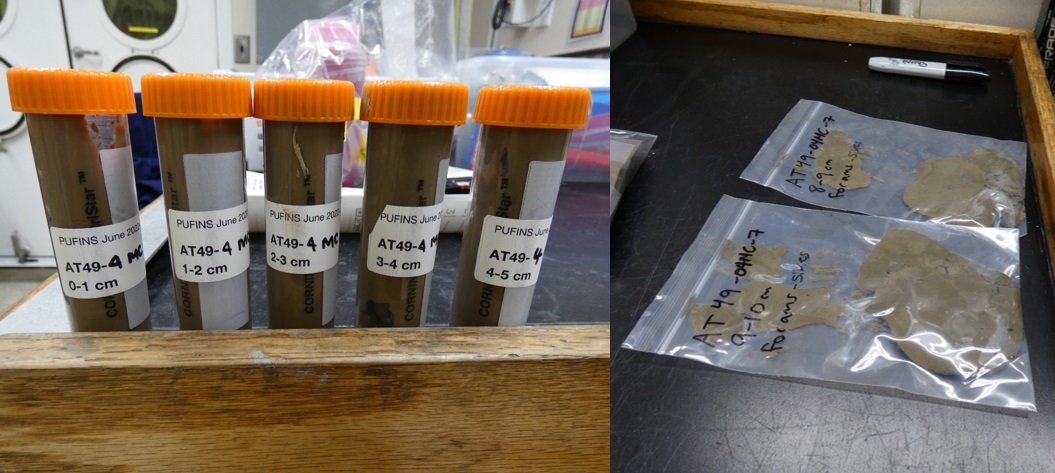We have had a lot of success collecting mud; what do we do next?
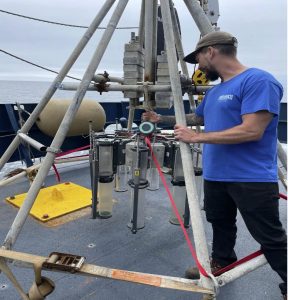
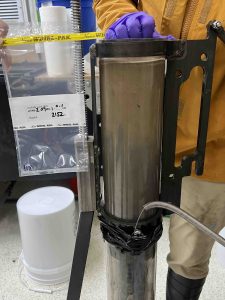
Multicores take much smaller, less disturbed, samples of sediment where the floor of the ocean contacts sea water. A quality multicore contains about 40 centimeters of sediment with ocean water captured from directly above that area of the ocean. The sediment and water should remain undisturbed in order to be pulled back up to the surface. The goal is to capture the mud layering closer to the surface so that the top layer of mud can be preserved. Then we compare that to the much longer core samples, which tend to use too much force and can sometimes spill the top layer over the edge of the pipe.
The multicore we use has 8 tubes to collect samples. The cores are stored on a custom tube holder where they await their fate of draining the water and splitting the core into the exact quantity and style the research is requesting. On this expedition the team is from many regions of the world, all interested in sediment samples from the North Atlantic, but how the researchers are choosing to analyze the samples are each different.
The tubes were assigned to the team based on the sample size collected. All tubes are indicated at the tube height and recorded in the Multicore Deck Log (see below). All tubes and slices are documented and often initially photographed with the first bag or vial to record the initial appearance of the tube. The data during the slices is recorded in a document like the one below.
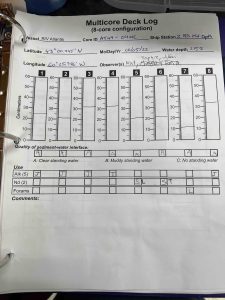
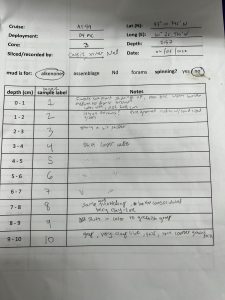
Five tubes were assigned for Dr. Sach’s research from the University of Washington. Two of those tubes had the first 10 centimeters split into vials to immediately centrifuge. The centrifuge process separates out substances in the vial by density. The water will be at the top of the vial to be drained and sealed separately so that the water can be studied further. Assistant Scientist Sophie Hines, of Woods Hole Oceanographic Institute, will be studying the rare earth metal neodymium that can be found in the sediment and water. Neodymium changes in the sediment are thought to be a valuable proxy for climate change, but more research in the flux of neodymium isotopes will help researchers confirm their usefulness.
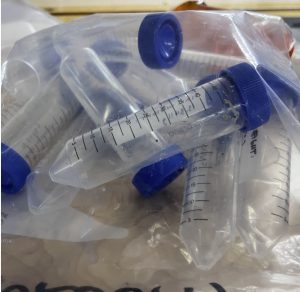
Some researchers requested samples after 10 centimeters to switch to bags and cut sections in 2 centimeter samples until the tube is completed. Other researchers wanted to cut sections 1 centimeter up to 15 centimeters deep.
The final tube for studying is micro-plastics in sediment. If one tube had a smaller amount of sediment present that tube was assigned for micro-plastic research for Dr. Umling with the American Museum of Natural History and Dr. Amy Wagner out of California State University, Sacramento. Micro-plastic research requires the team to change into cotton jumpsuits before opening the tubes to prevent contamination from our clothing which could contain micro-plastics (polyester).
After slicing and bagging the samples were grouped into gallon sized sealed bags and placed in the walk-in refrigerator for storage until we reach Woods Hole to unload them.
For information on how the gravity cores are stored see the video, Life of a Core.
